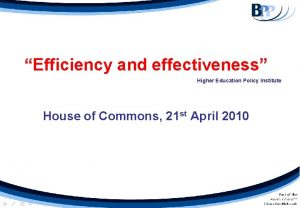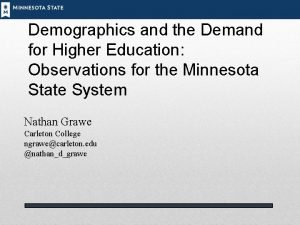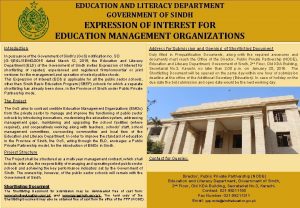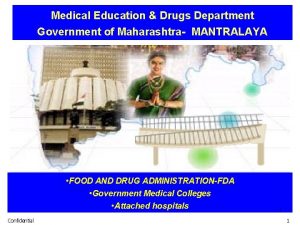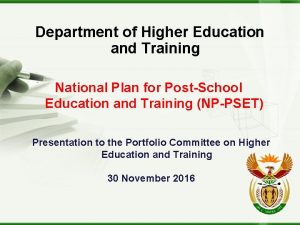Department of Higher Education and Training National Skills
























- Slides: 24

Department of Higher Education and Training National Skills Development Plan (NSDP) Presentation to Portfolio Committee of Higher Education and Training Wednesday, 22 August 2018

NATIONAL SKILLS DEVELOPMENT PLAN OUTLINE PART A: National Skills Development Plan Background National Skills Development Plan Principles National Skills Development Plan Outcomes National Skills Development Plan Institutional Arrangement PART B: SETA Landscape 2

NATIONAL SKILLS DEVELOPMENT PLAN BACKGROUND • The implementation of the National Skills Development Strategy Three (NSDS III) and the SETA institutional landscape was due to lapse on 31 March 2016 • In light of the above, the Department of Higher Education and Training (DHET) set in place a process to develop proposals to review the NSDS III and the SETA institutional landscape • The DHET considered two sets of documents to conceptualise the proposals for the NSDS III and the SETA institutional landscape: ü Policy Instruments : The White Paper for Post-School Education and Training outlines the policy imperatives of integrating the skills development system as a key component of the post-school education and training system ü Reports: Two key reports with recommendations based on the evaluation of the performance of the SETAs and the skills development system were produced. These reports are - the Ministerial Task Team report on SETA Performance as gazetted in 2013 and the Human Resource Development Council Skills System Review report of 2014 • The WP-PSET and review reports underpinned the proposals for reviewing the skills development system, specifically the NSDS and the SETAs; 3

NATIONAL SKILLS DEVELOPMENT PLAN BACKGROUND • The first proposal on the NSDS and SETA Landscape review was outlined on the NSDS and SETAS Landscape proposals for post 2016 (NSLP 2016) • The NSLP was issued by the Minister of Higher Education and Training (MHET) on 10 December 2015 for public comment • The MHET was inundated with requests to extend the period of engagement and consultation on the proposals for the SETA Landscape. Considering the nature and scope of the proposals to transform and review the SETAs, the Minister approved that the NSDS III and SETA Landscape be extended until 31 March 2020 so as to provide sufficient time to engage on the proposals and recommendations to transform and review the SETAs • Further, the public comments, consultation with the National Skills Authority (NSA), engagements at National Economic Development and Labour Council (NEDLAC), presentation to the Portfolio Committee and inter-government department engagements highlighted a number of concerns and recommendations in relation to the proposals outlined in the NSLP • The main concerns included that the review did not include recommendations related to other skills development institutions such as the Quality Council for Trades and Occupations, the role of the National Skills Authority and the National Skills Fund. Secondly, the proposals would require radical shifts which would result in the system focusing on aligning institutional arrangement shifts instead of skills development interventions. In the main, the NSLP was not supported 4

NATIONAL SKILLS DEVELOPMENT PLAN BACKGROUND • The second iteration of proposals outlined in the National Skills Development Plan (NSDP) were informed by the comments received on the NSLP, while also working closely with the WP-PSET planning task team. In addition, the National Development Plan (NDP) provided a key basis for refining the proposals for the Skills Development System • As such the proposals of the NSDP was extended to a skills development system and strategy review. Thus it is beyond just being a SETA Landscape review • The refinement of the proposals of the NSDP stems from a lengthy process of engagement and consultation with NSA, NEDLAC, intergovernmental engagements, Sector Education and Training Authorities (SETAs), Quality Councils (QCs) as well as a public comment phase • The NSDP proposals including the principles and outcomes are in the main supported as per public comments and engagement phase outputs • The NSDP was approved by the MHET in 2018 with further refinements and the introduction of specific outcomes for the skills system • The NSDP is now being presented to the NSA and key stakeholders for final consideration 5

NATIONAL SKILLS DEVELOPMENT PLAN BACKGROUND Contribution towards Key Policy Instruments Vision An educated, skilled and capable workforce for South Africa - National Development Plan - New Growth Path - White Paper for Post-School. . System - Industrial Policy Action - Economic growth - Employment creation - Productivity - Social Development Shifting to a Longer-term Plan 6

NATIONAL SKILLS DEVELOPMENT PLAN PRINCIPLES Principle 1: Locating the NSDP within an integrated post-school system • Promoting greater levels of integration within the post school-system: for planning, funding, monitoring, evaluation and reporting. Principle 2: Contributing to the country's socioeconomic objectives • Contribute to strategies and priorities of various sectors of the economy for an inclusive growth. Principle 3: Advancing an equitable and integrated system • Contribute towards transformational and developmental imperatives such as gender, race, class, youth, disability and geography. 7

NATIONAL SKILLS DEVELOPMENT PLAN PRINCIPLES PRINCIPLE 4: Greater inclusivity and collaboration PRINCIPLE 5: Focus on support system for learners and employers PRINCIPLE 6: Strong emphasis on accountability • Public and private sector collaborations; • Strong focus on workplace based in both public and private sector; • Quality education and training provision with strong articulation between programmes and qualification offerings. • Ensure prospective learners and the public are aware of when and how to access opportunities; • Employers where required are supported through simplified processes; • Standardisation of processes, systems, including stipends/learner allowances etc • Harness the use of technology. • Improve governance, monitoring and evaluation, • Review SETA Standard Constitution Regulations with stronger emphasis on accountability. 8

NATIONAL SKILLS DEVELOPMENT PLAN PRINCIPLES PRINCIPLE 7: Understanding demand • Analysis of sectoral growth, development plans and labour market – towards evidence based skills priorities and occupations in demand; • Research and innovation will be key. PRINCIPLE 8: Steering Supply – Qualifications and Provision PRINCIPLE 9: Steering Funding – Funding Mechanisms • Quality Councils will ensure the design, development and maintenance of occupational standards and qualifications. • Alignment between levy and fiscus funding. 9

NATIONAL SKILLS DEVELOPMENT PLAN OUTCOMES OUTCOME ONE: Identify and increase production of occupations in demand • Primary aim of determining occupations in high demand is to improve the responsiveness of the post -school education and training system to the needs of the economy and to the broader developmental objectives of the country; • National list of occupations in high demand will be produced and reviewed every two years; • The methodology of Centres of Specialisation will be encouraged. Sub Outcomes : • Targets for priority occupations; • Targets for priority qualifications; and • Indication of interventions required to improve enrolment and completion. Targets will be set for three year period annually determined through service level agreement 10

NATIONAL SKILLS DEVELOPMENT PLAN OUTCOMES OUTCOME TWO: Linking education and workplace • Improving the relationship between education and training and work is a key policy of the White Paper for Post-School and Education; • The WP-PSET is unequivocal that the main purpose of the TVET is to prepare students for the world of work; • OECD- TVET systems in 20 countries concluded that a key feature common to effective TVET systems everywhere is a focus on training for employment. Sub Outcome : • Opening of workplace based learning opportunities increased. Performance Indicators • Number of learners requiring work Intergrated learning placed; • Number of TVET lectures exposed to workplaces; • Number of learners participating in other various workplace based learning opportunities – learnerships, internships etc Targets will be set for three year period annually determined through service level agreement 11

NATIONAL SKILLS DEVELOPMENT PLAN OUTCOMES OUTCOME THREE : Improving the level of skills in the South African workforce • South Africa is challenged by low productivity in the workplace, as well as slow transformation of the labour market and a lack of mobility of the workforce; • From 2010 to 2014 the share of the employed with a matriculation certificates increased by 2. 6% from 49% to 52%, whilst the share of employed with tertiary education increased from 19. 3% in 2010 to 20. 5% in 2014; and • The number of and share of the employed with primary completed or lower was still over 2 million workers in 2014. Sub Outcome : • Increase the number of workers participating in various learning programmes from 37% in 2016 to the minimum of 80% by 2030. Performance Indicators • Number of workers trained and supported. 12

NATIONAL SKILLS DEVELOPMENT PLAN OUTCOMES OUTCOME FOUR : Increase access to occupationally directed programmes • NDP sets the target of 30 000 artisans produced annually by 2030, this is an indication that South Africa’s intermediate skills base is too low to support the country’s socio-economic development goals. Sub Outcomes : • Occupational qualifications developed; and • Increase access for intermediate and high level skills. Performance Indicators • Number of qualifications developed; • Number of artisans produced; • Dedicated grant for artisan development; • Artisan recognition of prior learning prioritised; • Partnerships established. Targets will be set for three year period annually determined through service level agreement 13

NATIONAL SKILLS DEVELOPMENT PLAN OUTCOMES OUTCOME FIVE : Support the growth of the public college system • The NDP situates TVET Colleges as critical pillars for social and economic development; • Countries with strong TVET colleges have good relationships between industry and the TVET Colleges; • Community Education and Training (CET) Colleges will cater for the knowledge and skills needs of the large number of adults and youth requiring education and training opportunities; • Stats SA estimates that more than 18 million people above 20 years have educational levels below the National Senior Certificates; • More than 3. 3 million youth aged 15 -24 years and 4. 6 million aged 25 -34 years who are not in education, employment or training (NEET). Sub Outcomes : • Support the TVET and CET Institutional Types Performance Indicators • Support of Centres of Specialisation; • Support colleges implementing occupational programmes; • Number of learners in workplace based learning opportunities and lectures exposed to workplace; and • Number of skills development support for the local small business and cooperatives. 14

NATIONAL SKILLS DEVELOPMENT PLAN OUTCOMES OUTCOME SIX: Skills development support for entrepreneurship and cooperative development • It is estimated that SMMEs contribute more than 30% to South Africa’s GDP. With regard to employment, SMMEs absorb about 70%-80% of the employed population but contribute less than 4% to export earnings; • Support for the cooperatives can play an important role, not just in the margins, but in the mainstream of the economy. Sub Outcomes • To increase support for entrepreneurial activities and the establishment of new enterprises and cooperatives. Performance Indicators • SETAs identify in their skills planning research, established and emergent enterprises and cooperatives and their skills needs; • Number of entrepreneurship and cooperative activities supported by skills levy institutions; and • Number of workplace based learning opportunities created. Targets will be set for three year period annually determined through service level agreement 15

NATIONAL SKILLS DEVELOPMENT PLAN OUTCOMES OUTCOME SEVEN : Encourage and support worker initiated training • Trade unions, their educational programmes as other worker-initiated programmes, play an important role in skilling workers in broader sectoral policy and capacity to effectively engage in the workplace and broader economy; • Worker initiated education and training can also contribute to the workforce that is better able to understand the challenges facing the economic sectors in which they operate. Performance Indicators • Skills Levy Institutions will work with the trade unions in their sectors in identifying the required skills needs, especially to better understand their sectors and implement relevant interventions. Targets will be set for three year period annually determined through service level agreement 16

NATIONAL SKILLS DEVELOPMENT PLAN OUTCOMES OUTCOME EIGHT: Support career development services • One of the milestones in someone’s life is to make a career choice, this decision will have significant impact on the rest of someone’s life; • The NDP talks about the need for every individual to ‘embrace their potential’, this embracing and freeing up is critical to the nations socio-economic development; • Career development services therefore, do not just aim to provide quality career and study related information and counselling but also contribute to the larger goal of assisting people our people to embrace and fulfil their potential; and • The OECD (2017) Report – Getting Skills Right in South Africa calls for the provision of a tailor made career advice services to students early on, based on better skills needs. Performance Indicators • Career development must be accessible especially in rural areas and for targeted beneficiaries of the NSDP and prioritisation of both sectoral and government priorities. Targets will be set for three year period annually determined through service level agreement 17

NSDP INSTITUTIONAL ARRANGEMENTS • Understanding demand signalling implications for supply • Steering the system to respond to skills supply; • Supporting the development of the institutional capacity of skills providers; • Performing system support functions and managing budgets Scope of SETAs • Longer term planning aligned to MTSF and fiscal allocation to educational institutional planning; • Reporting – non performance re claw back. Planning, Reporting and Accountability • Stakeholder Driven Boards; • Limit Board Size determined by DHET based on sector; • Limited duration • Board focus on Strategic (not operational) and DHET determine remuneration; • Administrator appointed based on review report by an Assessor appointed by the department. Accounting Authorities • Levy at 1% (NSF =20 and SETAs = 80%); • Mandatory Grant, Discretionary Grant and Administration Budget to be reviewed in alignment with the NSDP. Funding • Oversight role in accordance with Public Finance Management Act, Skills Development Act and applicable envisaged Regulations Executive Authority/DHET • Strengthen the role of NSA for monitoring and evaluation; • Strategic advice on improvement of the skills development system; • Be an expert body in skills development. National Skills Authority 18

NSDP INSTITUTIONAL ARRANGEMENTS • Focus on the unemployed; • Not in Employment Education and/Training; • Community Education and Training Sector; • Government priority programmes; • Small business and cooperative development; • Research in post-school National Skills Fund • Ensure that the required occupations are available : design, development and maintenance of occupational standards and qualifications; • Funding to be reviewed; • Quality assurance functions held by SETAs and National Artisan Moderation Body will be performed by QCTO. Quality Council for Trades and Occupations • Social partners will continue to play an active role, i. e. in Accounting Authorities and the NSA for the implementation, monitoring and evaluation of the NSDP. Social Partners 19

PROPOSED SETA LANDSCAPE SETA landscape review is guided by Section 9 of the Skills Development Act, 97 of 1998 (as amended). The following principles have been crafted to guide further the process: Fit for purpose Comprehensive coverage • Align skills development • Coverage of all strategies with national economic sectors; priorities and industrial • Employer based policy framework (inclusivity); • No special interest SETA; and • Alignment with the employment equity Viability and sustainability • Ability for the SETA to sustain functions and improve performance; • Securing sustainable income (levy) and resource based (financial viability) to support meaningful skills development interventions; • Operational and skills development activities based on funds available to the SETA and funds distribution leverages value add for skills development in the sector (financial Management. Value chain and proposition • SETAs dealing with related functions to be grouped together. 20

PROPOSED SETA LANDSCAPE No SETA RATIONALE 1. • Agriculture Sector Education and Training Authority Streamline and integrate the value chain of interrelated and interdependent sectors of forestry, agriculture, food and beverage subsectors. • Food and Beverages Manufacturing Industry Sector Education and Training Authority 2. • Financial and Accounting Services Sector Education and Training Authority Streamline and integrate the value chain of interrelated and interdependent sectors of finance, accounting, insurance and investment subsectors. • Banking Sector Education and Training Authority Insurance Sector Education and Training Authority 3. • Public Service Sector Education and Training Authority • Local Government Sector Education and Training • Energy and Water Sector Education and Training Authority Streamline and integrate the value chain of interrelated and interdependent sectors of the public service, local government, energy and water subsectors.

PROPOSED SETA LANDSCAPE No SETA RATIONALE 4. • Construction Education and Training Authority Streamline and integrate the value chain of interrelated and interdependent sectors by transferring electrical contractors subsector from EWSETA to CETA. • Energy and Water Sector Education and Training Authority 5. • Manufacturing, Engineering and Related Services Sector Education and Training Authority • Fibre Processing and Manufacturing Sector Education and Training Authority Streamline and integrate value chain of interrelated and interdependent sub-sectors of manufacturing, engineering clothing textile, footwear and leather and furniture, timber, printing, packaging and publishing. 6. • Education, training and Development Practices Sector Education and Training Authority No change proposed. 7. • Safety and Security Sector Education and Training Authority No change proposed. • Services Sector Education and Training Authority No change proposed. 8. 22

PROPOSED SETA LANDSCAPE No SETA RATIONALE 9. • Chemical Industries Education and Training Authority No change proposed. 10. • Media, Advertising, Information and Communication Technologies Sector Education and Training Authority No change proposed. 11. • Transport Education and Training Authority No change proposed. 12. • Culture, Arts, Tourism, Hospitality and Sport Education and Training Authority No change proposed. 13. • Wholesale and Retail Sector Education and Training Authority • Health and Welfare Sector Education and Training Authority No change proposed. 14. • Mining Qualifications Authority No change proposed. 15. 23

Thank you 24
 Department of higher education and training
Department of higher education and training Ohio department of higher education
Ohio department of higher education National higher education strategic plan
National higher education strategic plan Training for higher education professionals
Training for higher education professionals Guided hypermedia projects
Guided hypermedia projects Havering college of further and higher education
Havering college of further and higher education Efficiency and effectiveness in higher education
Efficiency and effectiveness in higher education Demographics and the demand for higher education
Demographics and the demand for higher education National risk and resilience department
National risk and resilience department Higher thinking skills through it based projects
Higher thinking skills through it based projects Hot question stems
Hot question stems Affective learning objectives examples
Affective learning objectives examples Higher order thinking questions examples
Higher order thinking questions examples Higher thinking skills through it based projects
Higher thinking skills through it based projects Interpersonal vs intrapersonal skills
Interpersonal vs intrapersonal skills Hard skill vs soft skill
Hard skill vs soft skill Department of labor and training
Department of labor and training Oklahoma department of career and technology education
Oklahoma department of career and technology education Sindh education and literacy department
Sindh education and literacy department Gde vision and mission statement
Gde vision and mission statement Gde mission and vision
Gde mission and vision Principal certification oklahoma
Principal certification oklahoma Education and literacy department
Education and literacy department Medical education and drugs department
Medical education and drugs department Higher education web analytics
Higher education web analytics






